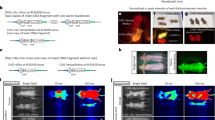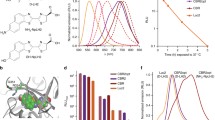Abstract
Bioluminescence imaging has evolved as a powerful tool for monitoring biological processesin vivo. As transmission efficiency of light through tissue increases greatly for wavelengths above 600 nm we examined whether a redshifted codon-optimized firefly luciferase (λmax = 615 nm) could be successfully employed as a sensitive reporter in mammalian cells. To this end, unmodified codon-optimized luciferase (λmax = 557 nm) as well as the red-emitting S284T mutant luciferase were expressed simultaneously in human glioma cellsin vitro as well as in quadriceps muscles of mice in vivo. We show here that activity of the redshifted enzyme in human glioma cell culture approached approximately one-fourth of that seen with the unmodified enzyme. In contrast, light emission by the red-emitting luciferase in vivo was generally more efficient than that produced by its unmodified counterpart, most likely due to reduced absorption of red light by tissue. The mean ratio of light emission produced by the redshifted luciferase to that of the unmodified enzymein vivo was ~3. Application of this new redshifted luciferase together with other optical reporters may be of considerable importance to biological research as it allows for imaging of deeper tissues as well as simultaneous monitoring of two molecular events in vitro and in vivo if appropriate filter sets are employed.
Similar content being viewed by others
References
H. Masuda, H. J. Okano, T. Maruyama, Y. Yoshimura, H. Okano and Y. Matsuzaki, In vivo imaging in humanized mice Curr. Top. Microbiol. Immunol. 2008 324 179–96.
Y. Ando, K. Niwa, N. Yamada, T. Enomoto, T. Irie, H. Kubota, Y. Ohmiya and H. Akiyama, Firefly bioluminescence quantum yield and colour change by pH-sensitive green emission Nat. Photonics 2008 2 44–47.
L. H. Naylor, Reporter gene technology: the future looks bright Biochem. Pharmacol. 1999 58 749–57.
D. J. Groskreutz, B. A. Sherf, K. V. Wood and E. T. Schenborn, Increased expression and convenience with the new pGL3 luciferase reporter vectors Promega Notes 1995 50 2–6.
C. H. Contag, P. R. Contag, J. I. Mullins, S. D. Spilman, D. K. Stevenson and D. A. Benaron, Photonic detection of bacterial pathogens in living hosts Mol. Microbiol. 1995 18 593–603.
H. Zhao, T. C. Doyle, O. Coquoz, F. Kalish, B. W. Rice and C. H. Contag, Emission spectra of bioluminescent reporters and interaction with mammalian tissue determine the sensitivity of detection in vivo J. Biomed. Opt. 2005 10 41210.
B. W. Rice, M. D. Cable and M. B. Nelson, In vivo imaging of light-emitting probes J. Biomed. Opt. 2001 6 432–40.
B. R. Branchini, T. L. Southworth, N. F. Khattak, E. Michelini and A. Roda, Red- and green-emitting firefly luciferase mutants for bioluminescent reporter applications Anal. Biochem. 2005 345 140–8.
N. Kajiyama and E. Nakano, Isolation and characterization of mutants of firefly luciferase which produce different colors of light Protein Eng. 1991 4 691–3.
B. F. Eames, D. A. Benaron, D. K. Stevenson and C. H. Contag, Construction and characterization of a red-emitting luciferase SPIE 1999 3600 36–39.
T. Arslan, S. V. Mamaev, N. V. Mamaeva and S. M. Hecht, Structurally modified firefly luciferase. Effects of amino acid substitution at position 286 J. Am. Chem. Soc. 1997 119 10877–87.
B. R. Branchini, D. M. Ablamsky, M. H. Murtiashaw, L. Uzasci, H. Fraga and T. L. Southworth, Thermostable red and green light-producing firefly luciferase mutants for bioluminescent reporter applications Anal. Biochem. 2007 361 253–62.
N. K. Tafreshi, S. Hosseinkhani, M. Sadeghizadeh, M. Sadeghi, B. Ranjbar, H. Naderi-Manesh, The influence of insertion of a critical residue (Arg356) in structure and bioluminescence spectra of firefly luciferase J. Biol. Chem. 2007 282 8641–7.
E. Shapiro, C. Lu and F. Baneyx, A set of multicolored Photinus pyralis luciferase mutants for in vivo bioluminescence applications Protein Eng. Des. Sel. 2005 18 581–7.
A. Söling, C. Theiss, S. Jungmichel and N. G. Rainov, A dual function fusion protein of Herpes simplex virus type 1 thymidine kinase and firefly luciferase for noninvasive in vivo imaging of gene therapy in malignant glioma Genet. Vaccines Ther. 2004 2 7–21.
N. K. Tafreshi, M. Sadeghizadeh, R. Emamzadeh, B. Ranjbar, H. Naderi-Manesh and S. Hosseinkhani, Site-directed mutagenesis of firefly luciferase: implication of conserved residue(s) in bioluminescence emission spectra among firefly luciferases Biochem. J. 2008 412 27–33.
S. V. Mamaev, A. L. Laikhter, T. Arslan and S. M. Hecht, Firefly luciferase: alterations of the color of emitted light resulting from substitutions at position 286 J. Am. Chem. Soc. 1996 118 7243–4.
J. A. Wolff and V. Budker, The mechanism of naked DNA uptake and expression Adv. Genet. 2005 54 3–20.
J. A. Wolff, J. J. Ludtke, G. Acsadi, P. Williams and A. Jani, Long-term persistence of plasmid DNA and foreign gene expression in mouse muscle Hum. Mol. Genet. 1992 1 363–9.
A. Kawase, T. Nomura, T. K. Yasuda, N. Kobayashi, M. Hashida and Y. Takakura, Disposition and gene expression characteristics in solid tumors and skeletal muscle after direct injection of naked plasmid DNA in mice J. Pharm. Sci. 2003 92 1295–304.
H. L. Davis, R. G. Whalen and B. A. Demeneix, Direct gene transfer into skeletal muscle in vivo: factors affecting efficiency of transfer and stability of expression Hum. Gene Ther. 1993 4 151–9.
M. Manthorpe, F. Cornefert-Jensen, J. Hartikka, J. Felgner, A. Rundell, M. Margalith and V. Dwarki, Gene therapy by intramuscular injection of plasmid DNA: studies on firefly luciferase gene expression in mice Hum. Gene Ther. 1993 4 419–31.
A. Bachmair, D. Finley and A. Varshavsky, In vivo half-life of a protein is a function of its amino-terminal residue Science 1986 234 179–86.
J. F. Thompson, L. S. Hayes and D. B. Lloyd, Modulation of firefly luciferase stability and impact on studies of gene regulation Gene 1991 103 171–7.
G. M. Leclerc, F. R. Boockfor, W. J. Faught and L. S. Frawley, Development of a destabilized firefly luciferase enzyme for measurement of gene expression Biotechniques 2000 29 590–8.
J. E. Souren, F. A. Wiegant, R. Van Wijk, The role of hsp70 in protection and repair of luciferase activity in vivo; experimental data and mathematical modelling Cell Mol. Life Sci. 1999 55 799–811.
J. A. Wolff, P. Williams, G. Acsadi, S. Jiao, A. Jani and W. Chong, Conditions affecting direct gene transfer into rodent muscle in vivo Biotechniques 1991 11 474–85.
E. H. Moriyama, M. J. Niedre, M. T. Jarvi, J. D. Mocanu, Y. Moriyama, P. Subarsky, B. Li, L. D. Lilge and B. C. Wilson, The influence of hypoxia on bioluminescence in luciferase-transfected gliosarcoma tumor cells in vitro Photochem. Photobiol. Sci. 2008 7 675–80.
S. Bhaumik, X. Z. Lewis and S. S. Gambhir, Optical imaging of Renilla luciferase, synthetic Renilla luciferase, and firefly luciferase reporter gene expression in living mice J. Biomed. Opt. 2004 9 578–86.
M. Otto-Duessel, V. Khankaldyyan, I. Gonzalez-Gomez, M. C. Jensen, W. E. Laug and M. Rosol, In vivo testing of Renilla luciferase substrate analogs in an orthotopic murine model of human glioblastoma Mol. Imaging 2006 5 57–64.
E. Michelini, L. Cevenini, L. Mezzanotte, D. Ablamsky, T. Southworth, B. R. Branchini and A. Roda, Combining intracellular and secreted bioluminescent reporter proteins for multicolor cell-based assays Photochem. Photobiol. Sci. 2008 7 212–7.
H. Dehghani, S. C. Davis, S. Jiang, B. W. Pogue, K. D. Paulsen and M. S. Patterson, Spectrally resolved bioluminescence optical tomography Opt. Lett. 2006 31 365–7.
Author information
Authors and Affiliations
Corresponding author
Rights and permissions
About this article
Cite this article
Caysa, H., Jacob, R., Müther, N. et al. A redshifted codon-optimized firefly luciferase is a sensitive reporter for bioluminescence imaging. Photochem Photobiol Sci 8, 52–56 (2009). https://doi.org/10.1039/b814566k
Received:
Accepted:
Published:
Issue Date:
DOI: https://doi.org/10.1039/b814566k




